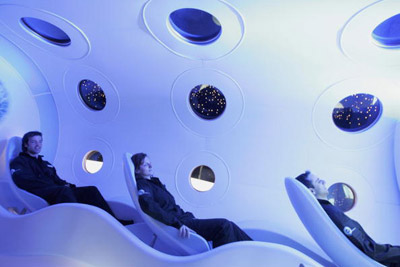Is space tourism safe?

Sometime in 2009, George Whitesides, the executive director of the National Space Society, and his wife will be the first private citizens to fly with Virgin Galactic, the private space tourism company started by billionaire Sir Richard Branson. Mr. and Mrs. Whiteside paid $200,000 each to launch 400,000 feet into suborbital space. They’ll experience weightlessness for a few minutes before they’re pulled back down to the Earth by gravity.
Although it’s an expensive endeavor, space travel has reached a turning point, with private citizens able to make their own reservations for spaceflights. But how safe could a space tour actually be?
The space tourism industry is currently going through its own race — although it doesn’t have the same tense political implications as the nuclear arms race did, many people are concerned about the safety of sending citizens into space like they’re on a roller coaster. The history of space flights and exploration is scattered with near disasters and fatal catastrophes, from Apollo 13 in 1970 to the Columbia explosion in 2003. These flights were funded, developed and launched by governments and organizations like NASA. Space tourism programs, on the other hand, are run and developed by private companies, and the whole concept is really just beginning. One would suspect the safety of paying customers, along with citizens on the ground, is a top priority to those interested.
Space tourism is a rapidly expanding industry that should appeal to wealthy travelers and extreme sports fans — it’s sort of like a modern-day safari, except on a rocket ship shooting through space. How safe would a tour into space be? Who’s regulating these businesses in their early stages, if anyone? Has the government weighed in at all? How much do participants know going into a space tour? Do they have to sign anything?
To learn more about your chances of survival on a really expensive joyride, read the next page.
Space Tourism Safety
Sir Richard Branson poses for a photograph during Australia’s first private sign up to become a space tourist on Dec. 13, 2005.
Sir Richard Branson poses for a photograph during Australia’s first private sign up to become a space tourist on Dec. 13, 2005.
PATRICK RIVIERE/GETTY IMAGES
A recent poll of affluent Americans suggests that space tourism could create more than $1 billion in revenue by 2021 [source: FAA]. It’s obvious that people are interested and eager to see what it’s like in space, and to many it’s a dream come true, but no one doubts the risks inherent in such an industry.
On one hand, companies see space tourism as a profitable endeavor, so they want to move forward as quickly as possible in order to compete. On the other, accidents caused by overly hasty production could trouble the industry if the public sees it as too dangerous. In order to balance these two concerns, the U.S. government has weighed in on the subject.
The United States Code is a collection of general and permanent federal laws Congress keeps and amends when necessary. It’s simply a big list of subjects, which includes laws in relation to labor, education, patents, food and drugs and, of course, transportation. Under the transportation section, Title 49, there are several subsections, one of which is Subtitle IX — Commercial Space Transportation.
The year 2004 marked the turning point for space tourism, including the commercial space transportation laws. SpaceShipOne, the first private manned spaceship to launch higher than 328,000 feet twice within two weeks, won the $10 million Ansari X-Prize in 2004. Congress, meanwhile, recognized the potential the space tourism industry has. It passed the Commercial Space Launch Amendments Act of 2004, updating the law to include “human space flight” in the literature. The amendment notes that “the public interest is served by creating a clear legal, regulatory, and safety regime for commercial human space flight; and […] the regulatory standards governing human space flight must evolve as the industry matures so that regulations neither stifle technology development nor expose crew or space flight participants to avoidable risks” [source: FAA].
The organization called upon to follow those guidelines is the Federal Aviation Administration FAA, the same agency responsible for regulating the safety of commercial air traffic. Their job is a tricky one. Representatives from the FAA will attend every launch, evaluate every landing and work alongside people in the space tourism industry, but they aren’t allowed to impose any safety regulations until 2012 unless there’s a serious accident. Once a spacecraft is up in the air, the FAA has no say on what happens — Congress feels this is the best way to allow the industry to expand in a short amount of time. The FAA also requires that space tourists should have to agree to act as “participants,” not “passengers,” during flights, since the expectations of safety will be lower on a space tour. Citizens must also agree not to sue the government if there’s a fatal accident.
Because it’s so early in development and the FAA can’t control how companies design their vehicles, it’s hard to say how safe or unsafe launching citizens into space will be. During a panel discussion over safety regulations, however, Tracey Knutson, a lawyer advising the FAA on the matter, said: “We’re going to kill some people” [source: USA Today].
One company has already experienced setbacks with accidents.



 Creators of mankind
Creators of mankind Description of “Tall white aliens”
Description of “Tall white aliens” Where they came from?
Where they came from? About hostile civilizations
About hostile civilizations The war for the Earth
The war for the Earth “Tall white aliens” about eternal life
“Tall white aliens” about eternal life Video: “Nordic aliens”
Video: “Nordic aliens” Aliens
Aliens Alien encounters
Alien encounters The aliens base
The aliens base UFO
UFO Technology UFO
Technology UFO Underground civilization
Underground civilization Ancient alien artifacts
Ancient alien artifacts Military and UFO
Military and UFO Mysteries and hypotheses
Mysteries and hypotheses Scientific facts
Scientific facts


















